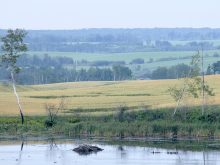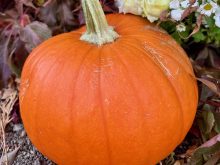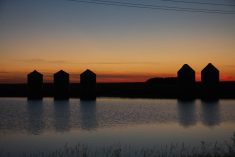While visiting with friends in Arizona, the question arose about the difference between white and dark vanilla. The topic came up as some snowbirds drive over the U.S. border into Mexico to pick up their yearly supply of white vanilla. White vanilla is also available from Watkins dealers in Canada and the United States.
Dark vanilla may be natural, made from pureed vanilla beans, or artificial, made from a synthetic substance such as vanillin (from wood pulp) or other approved substitute that imitates the smell and flavour of natural vanilla. White vanilla, because it is colourless, contains no real vanilla (vanilla cannot be made clear), and will be artificial. Its crystal-clear formula is designed not to discolour white foods such as frostings, whipped creams and wedding cakes.
Read Also

Rural Manitoba resources slim on natural disaster planning
A study from Brandon University’s Rural Development Institute has found that many rural and small municipalities don’t have the staff or resources to make formal climate plans against natural disaster.
Here are other foods with light and dark varieties.
- Pepper – The pea-sized berries of the pepper shrub are bright red when ripe. When the skin and fleshy parts are removed, the remaining hard seed is white. Black pepper is made from unripe berries. When unripe berries are picked, dried and winnowed, they are black and biting, with a sweet undertone. This is best when ground fresh in a pepper mill.
- Cranberry juice – White cranberry juice drinks are milder and less tart than the red cranberry juices. They are made with natural white cranberries that are harvested a few weeks earlier than the red.
- Chocolate – Dark chocolate is made from roasted cocoa beans. White chocolate isn’t a true chocolate because it contains no chocolate liquor and has very little of the flavour. Instead, it’s usually a mixture of sugar, cocoa butter, milk solids, lecithin and vanilla.
- Sugar – White sugar is known by many names, including sucrose, table sugar, cane sugar, beet sugar, grape sugar, refined sugar or granulated sugar. It is derived from the juice of sugar cane or sugar beets. Once extracted, the sugar juice is processed extensively to produce a white, granulated substance. In one of the processing steps, molasses is separated out in a centrifuge.
Brown sugar is simply regular refined sugar with some of the molasses returned to it. Light brown sugar contains 3.5 percent molasses while dark brown sugar has about 6.5 percent. Molasses adds moisture and a distinctive flavour.
Brown sugar can be substituted for refined sugar, measure for measure, in any formulas where its flavour is desired.
HeartSmart turkey recipes
The Manitoba Turkey Producers has printed a colourful little booklet called Tasty & Tempting HeartSmart Turkey Recipes. It contains 11 pages of recipes, nutritional facts and other bits of information about turkey.
All the recipes provide the nutrient analysis information to help with healthy eating. The HeartSmart symbol is on the front cover, a registered label owned by the Heart and Stroke Foundation of Canada.
The recipes are written to help busy people put together a home-cooked meal. For example, start with a turkey breast marinated in Italian salad dressing and then grilled. Ground turkey is a tasty addition to make-ahead casseroles, or combine it with taco seasoning for a fast Mexican meal. Or, coat turkey cutlets and tenderloins with your favourite spices, bake or broil, and serve with a salad and rice for an easy, elegant meal in minutes.
Call the Manitoba Turkey Producers recipe request line at 204-934-1860 or visit www.turkey.mb.ca.
Spring’s first fruit
The first tender rhubarb picking of the year is always a treat. Mine was also the first picking from a Valentine rhubarb planted in our new town yard last summer. Valentine is one of the red varieties of rhubarb recommended by the University of Saskatchewan. It didn’t disappoint.
We can’t let spring go by without sharing a rhubarb recipe. This pie recipe is from a local Hughton United Church Cookbook, printed in 1960. It was one of my first cookbooks, given to me by a dear neighbour at my bridal shower.
By now the pages are just barely hanging together, but it still gets taken from the shelf and used when making old favourites like this pie recipe.
Rhubarb custard pie
4 egg yolks
13/4 cups granulated sugar 425 mL
1/2 teaspoon salt 2 mL
3 tablespoons flour 45 mL
3/4 cup cream or 175 mL
evaporated milk
21/2-3 cups rhubarb, cut 625-750 mL
small
1 teaspoon cinnamon, 5 mL
(optional)
Beat egg yolks well. Add sugar, salt and flour that have been mixed together. Add cream and rhubarb. Leave for 15 minutes before putting in uncooked pastry shell. Bake at 375 F (190 C) until firm, which will be an hour or more.
Top with meringue or whipped cream. The pie may also be made with a closed or lattice top.
A reliable cake
Thanks to a British Columbia reader for this recipe. I tried it and it turned out great. I found one-half of the icing recipe will ice the cake nicely.
Dear TEAM: I always appreciate when I get a recipe that is someone’s “old faithful.” This cake turns out every time and has eye appeal as well. It is always a hit at birthday parties and potlucks. It freezes well and I like to have one in the freezer for emergencies. I cut the recipe out of some farm paper years ago, and have been making it ever since. It takes about 10 minutes to mix and it always rises over the top of the pan. – R.S., Fort St. John, B.C.
Golden chiffon cake
Measure into large mixing bowl:
13/4 cups flour 425 mL
11/2 cups sugar 375 mL
3 teaspoons baking 15 mL
powder
1 teaspoon salt 5 mL
Stir to blend.
Add:
5 egg yolks
1/2 cup canola oil 125 mL
3/4 cup water 175 mL
2 teaspoons vanilla 10 mL
Leave sit.
Measure into a bowl:
1 cup egg white 250 mL
(about six large eggs)
1/2 teaspoon cream of 2 mL
tartar
Beat egg whites and cream of tartar until very stiff peaks form. Then beat the flour mixture for two minutes. Carefully, with a spatula, fold the beaten egg white into the flour mixture. Turn into an ungreased 10 inch (25 cm/3 L) tube pan.
Bake for 55 minutes at 325 F (160 C), then increase temperature to 350 F (180 C) and bake 10 minutes longer. Invert pan to cool. Run knife around edge to loosen and remove cake from pan. Serve plain, frosted or with fruit.
Speedy snow frosting
Bring 11/2 cups (375 mL) corn syrup to a boil. Beat two egg whites to stiff, moist peaks. Slowly pour boiling syrup into beaten egg whites while continuing to beat.
Beat till stiff and shiny, about five minutes. Add food colouring, if desired. Generously frosts a 10 inch (25 cm/3 L) tube cake.
Hort week
The Extension Division at the University of Saskatchewan is again hosting Hort Week, July 20 to 25. It is a week-long program of gardening sessions, filled with lectures, garden tours and hands-on sessions that are open to the public. To view the schedule, go to www.extension.usask.ca/go/hortweek. For registration information, contact 306-966-5539. For information about workshops, call Patricia Hanbidge, 306-966-5749.
Plants toxic to livestock
DEAR TEAM: I would like to know about any yard or garden plants that may be toxic or poisonous to livestock. – P.C., Yorkton, Sask.
Dear P.C. – The agrologist in our area had information about the following plants that are toxic for livestock. Toxicity can be produced by ingesting parts of some plants, such as the leaves, stems, roots or fruit.
- Larkspur – All parts, especially young plants and seeds.
- Arrowgrass – All parts.
- Bracken fern – All parts, green or dry, especially the rhizome.
- Greasewood – All parts, especially buds and young leaves.
- Groundsel – All parts.
- Milk vetches – All parts.
- Lupine – All parts, especially seeds.
- Monkshood – All parts, especially roots and seeds.
- Death carnas – All parts, especially bulbs.
- Oak tree – Leaves, unleached acorns and young shoots.
- Chokecherry – All parts. Fruit is safe if pits are removed.
- Common cattail – Leaves and stems.
- Horsetail — All parts.
- Mountain laurel – All parts.
- Water hemlock – Leaves and roots.
Under normal conditions, livestock avoid these plants. However, during drought or when the preferred forage is no longer available, livestock will try plants.
Source: You and Toxicology, by H. Bruno Schiefer, Donald G. Irvine, Shirley C. Buzik, a 1986 publication of the Toxicology Centre, University of Saskatchewan, Saskatoon.
Cookbook draw
Send your name and address to: TEAM Resources Cookbook Contest, Box 2500, Saskatoon, Sask., S7K 2C4. Deadline for entries is June 13. A draw will be made from all the entries received and an ATCO Blue Flame Kitchen Everyday Delicious cookbook will be sent to the winners.
Alma Copeland is a home economist from Rosetown, Sask., and one of four columnists comprising Team Resources. Send correspondence in care of this newspaper, Box 2500, Saskatoon, Sask., S7K 2C4 or contact them at team@producer.com.














